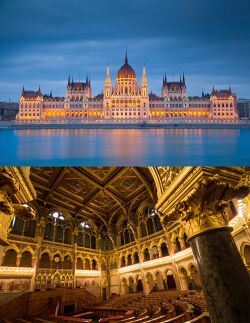Julian Palace
This article is a work-in-progress because it is incomplete and pending further input from an author. Note: The contents of this article are not considered canonical and may be inaccurate. Please comment on this article's talk page to share your input, comments and questions. |
| Julian Palace | |
|---|---|
Palatium Julii | |
 Exterior of the Julian Palace and interior of the Concilium Daoni chamber | |
| Etymology | Julian dynasty |
| General information | |
| Architectural style | Gothic Revival |
| Location | Urceopolis, Archduchy of Urceopolis |
| Country | Urcea |
| Construction started | ca. 500 AD |
| Renovated |
|
| Owner | Government of Urcea |
| Known for | Official residence of the Apostolic King of Urcea Seat of the Government of Urcea |
The Julian Palace is a royal residence and the seat of the Government of Urcea. The building contains the Julian Throne and Crown Jewels of Urcea, as well as the throne room, royal apartments, chambers for both the Concilium Purpaidá and Concilium Daoni, in addition to office space for leadership of both councils, including offices for the Procurator and Chancellor and Temporary President. While the Julian Palace is nominally the official royal residence of the Apostolic King of Urcea, the King and his courtiers primarily reside in Castle Welute outside of the city of Urceopolis proper.
History
The Julian Palace began life in the early 6th century as a relatively large home of the Julii called the Domus Julii. With the fall of Great Levantia, the custom of noble families in Urceopolis had evolved to building relatively large urban estates that could be fortified. Though not especially politically influential, the Julii began construction on their large fortified manor, which was completed by 515. Levantine contemporaries note that the Domus Julii was far larger and more impressive than that of the Brutonii and Neronii, despite the power held by those families. Despite its size, the distance from the Forum attests to the political and social status of the Julii at the time.
The fortunes of the Julii did not change with the organization of the Duchy of Urceopolis in the 640s. The major reversal of fortunes came as a prominent son of the family, Gaius Julius Cicurinus won fame on the battlefield on behalf of the Latin League against Hištanšahr, and, in 749, Julius was elected Dux of Urceopolis. Living and doing business in the Domus Julii, the complex began to be an important center of Urceopolitan civic life. With the advent of the Levantine Empire and elevation of the Julii to hereditary control over the newfound Archduchy of Urceopolis, the Domus Julii became the focal point of political power and the home of the hereditary Archdukes of Urceopolis. Accordingly, the first Archduke began a major renovation of the Domus Julii in 791. The renovation transformed the building from the reserved mansion of Late Antiquity to a towering Levanesque building based on the recently constructed Imperial Palace in Corcra. It was completed in 804, after the death of Archduke Julius, who would soon become known to history as Saint Julius I. The Domus Julii became increasingly known as the Palatium Julii, the Julian Palace, as its position as home of the hereditary ruling Archduke was solidified.
Renovations and evolution
Interior
The Julian Palace is roughly divided into three wings, with the central wing serving as throne room for the Apostolic King of Urcea including apartments for the Royal family, the southern wing serving as chambers for the Concilium Purpaidá including limited office space for its members, and the northern wing serving as the chambers for the Concilium Daoni with limited office and committee space included in the building. In addition to the three main wings, there is a smaller central area, including the building's main rotunda, which serves as a depository for the Crown Jewels and also as a public museum. The Royal Household offices are not located within the Palace, and a majority of Daoni offices and meeting spaces are located in adjacent office buildings within the Pale's New City borough.